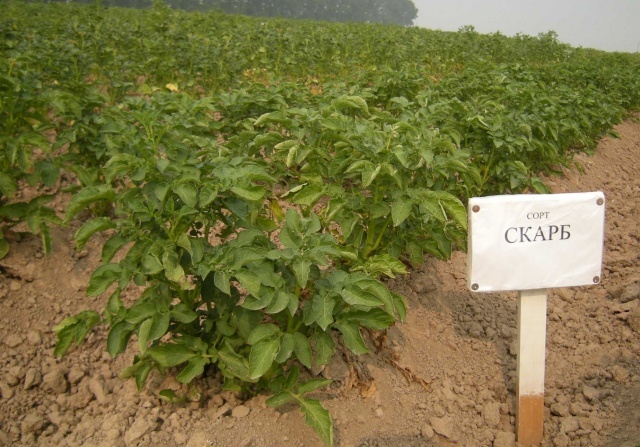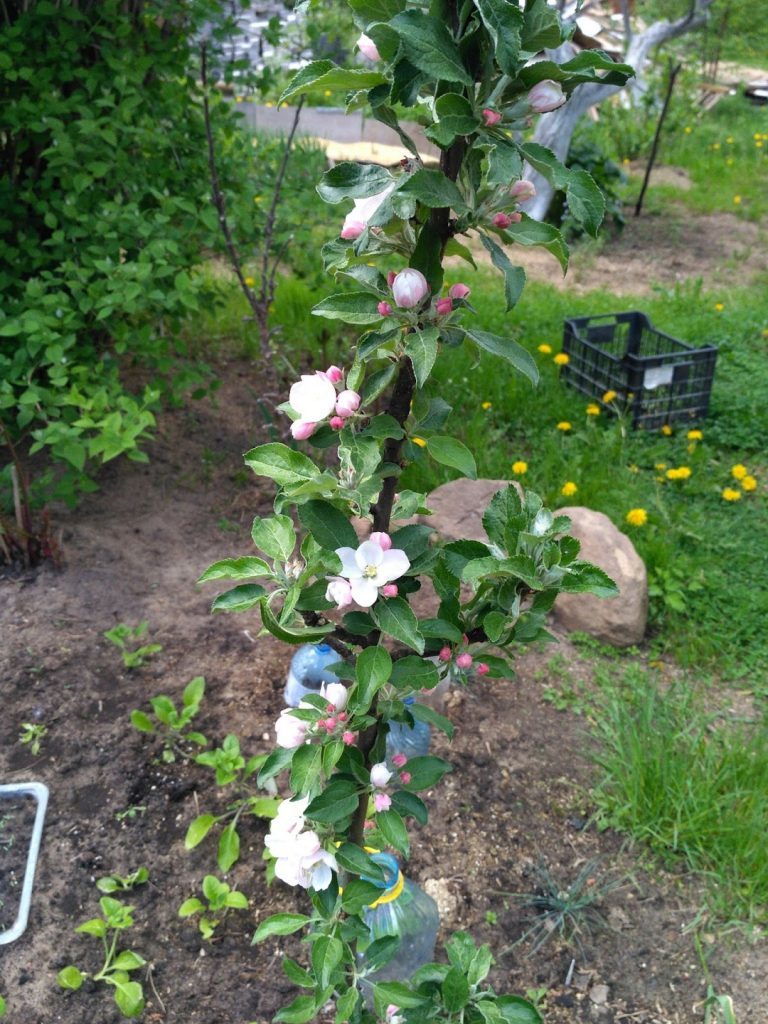Potato Scarb has attractive characteristics for vegetable growers. It is more productive than the famous Nevsky. Its elongated tubers fit comfortably in the palm of your hand, its eyes are small. Such potatoes are easy and pleasant to peel. Truly yellow hides inside, moderately flesh crumbling during cooking. But, as usual, there are also negative aspects that have to be taken into account when growing.
Content:
- History of Scarb Potatoes
- Grade description
-
Growing Potatoes Scarb
- Video: vernalization of potatoes for accelerated germination
- Video: the danger of late blight and how to protect potatoes from it
- Reviews gardeners about potatoes Scarb
History of Scarb Potatoes
The variety was created in the Scientific Center of Potato and Horticulture of Belarus. The institution is located near Minsk, in the village of Samokhvalovichi. An application for variety testing in Russia was submitted in 1999, and in 2002 Scarb was introduced to the State Register as a selection achievement.
The variety is zoned for four regions: Central, Northwest, Volga-Vyatka and Ural and does not meet the expectations of gardeners of the northern and southern territories and regions. Despite this, Scarb is one of the most popular varieties in the Russian Federation. There are so many laudatory reviews about him on the Internet that statements of dissatisfied are lost against their background. Single negative reviews cause the only controversial quality - taste.
Grade description
Obtaining the promised yield from Scarb potatoes will be really difficult in regions with a short summer. This is a mid-ripening variety, the ripening period is about 100 days after emergence. Not only that, seed tubers germinate for a long time, seedlings are unprotected, and the reason is a very long period of dormancy. In spring, this is a drawback, seed tubers need to be woken up (warm and germinate). But after the harvest, the disadvantage turns into an important advantage.
Commercial tubers retain their density, do not grow loose and do not germinate in storage until September-October, that is, until the next harvest. Keeping grade - 99%. Skarb is an unsurpassed variety in storage time! If your cellar has sufficient supplies of Scarb, you don’t have to plant early hats or dig small potatoes in the middle of summer.
Scarb bushes of medium height, slightly sprawling, bloom with white corollas. In each, 10–14 potatoes weighing 94–138 g. On an industrial scale, 25.3–41.1 tons are harvested per hectare, the record yield for this variety is 50.8 t / ha. Accordingly, depending on the weather and the quality of leaving from one hundred square meters, you can get up to 250-500 kg of potatoes.

Scarb bushes are low, a little sprawling
Scarb tubers are oval, the skin is smooth, yellow, the eyes are very small. 84–99% of potatoes have a good presentation, almost no ugly ones. The pulp is yellow, contains up to 17.7% of starch. And although in the State Register the taste is called good, but not excellent, the variety behaves ideally in many dishes. Scarb makes a very delicious fried potato; it does not dissolve in soups. The flesh crumbles only during prolonged cooking. The variety is well suited for the preparation of salads, chips, french fries, and frozen vegetable mixtures.

Scarb tubers are oval, yellow in section
A big plus is Scarb's resistance to nematodes and scab. Its tubers cannot be deeply embedded. These properties make the variety compatible with natural farming - growing vegetables without deep plowing and the use of chemicals. However, chemistry cannot be completely dispensed with: this potato is susceptible to late blight of tubers and tops.
Growing Potatoes Scarb
Vegetable growers noticed that Skarb gives maximum crops on sandy loamy lands, which allow air and moisture to pass through well. Clay soil can be improved by adding loosening materials: peat, humus, compost, rotted sawdust, hay dust, green manure. These materials will also serve as food, because potatoes are a culture that needs organic.
Transfer the Scarb seed tubers to heat (+ 18... +22 ° C) a month before the expected day of planting. During this period they will warm up and sprout. To prevent late blight, moisten tubers before sprouting or sprinkle with a solution of copper sulfate (10 g per 10 l of water).
Video: vernalization of potatoes for accelerated germination
Start planting when the temperature of the soil is not lower than +10 ° C. Do holes, retreating 30 cm from one another, row spacing - at least 60–70 cm. The wider the aisles, the larger the potatoes in the bushes. Depth of embedment - 5-7 cm. Being close to the surface of the earth, tubers receive more solar heat and germinate faster.
Already at the landing stage, take care of protecting Skarb from the Colorado potato beetle and wireworm. To do this, spray the spreading potatoes and the soil in the holes with an insecticide: Prestige, Commander, Taboo or others.
Shoots will appear at least a week later, and when they grow to a height of 10-15 cm, make the first hilling, it should be high. In this way, small planting is compensated, the bushes are able to form additional roots and tubers. Before flowering, as the tops of the Scarb grow, they need to be spudded another 1-2 times with moist ground.
Watering plays an important role for this variety. It is not highly drought resistant.. Irrigation of the field at the beginning of the growing season will give a good start, but you do not need to pour potatoes. Keep the earth moist. Water if the weather is hot for a week without rains. For varieties that are unstable to late blight, do not use sprinklers, let water out of the hose in the aisles. If there is no way to water, then cover the aisles with mulch so that the earth does not dry out and does not crack.

Water the Scarb under the root, filling the aisles with water
Without mulch, until the tops of the aisle are closed, after each rain and watering, loosen. To the roots, for their good development, air must flow. The scrub actively assimilates nutrition from soil filled with organic matter, but will respond with increased yield to top dressing:
- At the beginning of the growing season, add under the bushes nitrogen-rich infusions of mullein, droppings, nettles, or urea solution (1 tbsp. l for 10 liters of water).
- In the phase of budding and flowering, potatoes need: phosphorus, potassium, trace elements. Wood ash or special mixtures and concentrates for potatoes and vegetables are well suited: Fertika, BioMaster, Agricola, etc.
To prevent late blight, from the beginning of the growing season, spray the bushes every 2 weeks with a solution of the biological product Fitosporin. At the first sign of a disease, if there is more than a month before harvest, you can treat it with fungicide: Skor, HOM or Horus. In the fall, a week before digging, to prevent the disease from switching from tops to tubers and soil, cut off all shoots and carry them away from the site.
Video: the danger of late blight and how to protect potatoes from it
Harvest in dry sunny weather. Dry the tubers for storage on the day of digging in the sun, and then transfer for a week to a cool, dark and ventilated room. During this period, the peel will become rougher and become resistant to damage and rot. Tubers ripened in this way can be sent to the cellar or basement.
Hold the seed tubers for several days in the light for gardening. It will be useful if you wash them in a solution of copper sulfate, potassium permanganate or boric acid. These drugs will destroy fungi of diseases that could get on the surface of potatoes. Dry the washed potatoes well.
Owners of this variety say that its yield decreases after the third reproduction. So, seed tubers can be selected for planting from bushes only for three years, and for the fourth you should buy mini-tubers or grow them yourself from botanical seeds.

Mini-tubers grow from seeds ripening in the ground fruits (bulbs) of potatoes
Reviews gardeners about potatoes Scarb
I took it from the farmers to taste Skarb, because I love the yellow varieties. And not just yellow, but yellow! How Adretta was. We really liked the Scarb - almost the same as Adretta. We will start.
I want to talk about SCARB. Excellent potato - fruitful, boiled, oily to taste (much tastier than blue eyes). The bushes are stunted and sprout later than the rest. Harvest more than Nevsky and Good luck. Unfortunately there are no records at hand and I can’t say how much. A very dense peel of light brown color with a mesh and rich yellow flesh. Good such bast shoes with a palm. The eyes are small and very comfortable to clean. We decided to plant it more. The next year left her and good luck
We plant a lot of Scarb, he has been with us since 2005. Always fruitful, delicious, yellow flesh. Tasty. Favorite variety.
Scarb is not tasty. I have it.
And I really like Scarb, I like yellow potatoes. And it is stored for a very long time.
Scarb liked the taste, yellow, boiled.
Scarb has proven its productivity and excellent qualities to many gardeners. But the variety does not demonstrate high yields in every Russian region. It should be planted if it is zoned for your area. In care, focus on the prevention of late blight and watering, especially at the beginning of the growing season.
© 2019, homeli.ru. Copying is allowed only with a link back to the source


